#Utahraptor ostrommaysorum
Explore tagged Tumblr posts
Text
after months. i have improved upon my most enjoyed Image and fully redrew it. here u go utahraptor in tree V2

#utahraptor ostrommaysorum#utahraptor#theropoda#theropod#dromaeosaur#paleoart#paleoblr#orange.png#orange.art
217 notes
·
View notes
Text
Thanks, @t3acupz for tagging me.






Not tagging etc.
Hi my friends! I am both interested about my moots and need a fun distraction in my life right now. That means a tag game>:3 MWAHHAHAH those who get tagged are invited to answer there questions below ⬇️ I’ll start!
Go to Pinterest and Search:
1. Color of your phone case + aesthetic
2. Fave animal + aesthetic
3. Name + core
4. Favorite movie + aesthetic
5. Name of favorite song + aesthetic
6. Your birth month + core

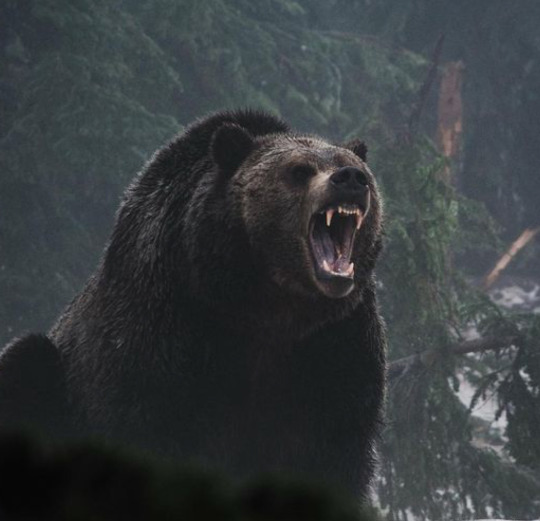


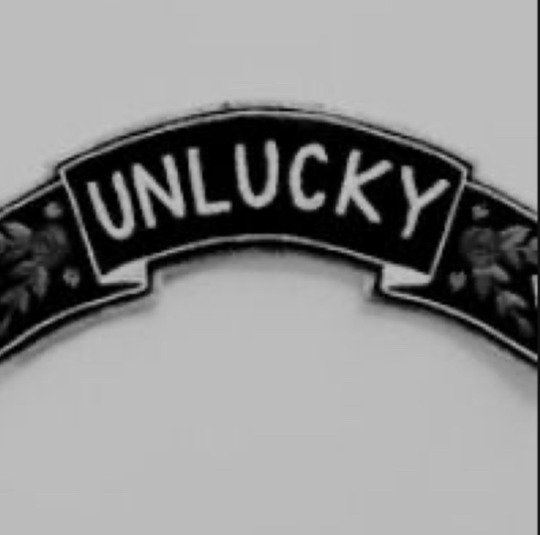
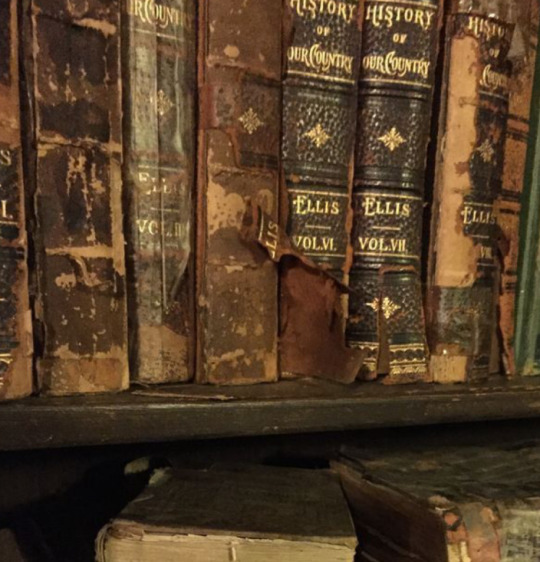
Tags!: @gunnrblze @lemonqii @bellspun @spicelold @milkteaarttime @imagoddamnonionmason
#ask game#já a švábi#Utahraptor ostrommaysorum#How to Train Your Dragon#I Wanna Be Your Slave#Not half bad.
403 notes
·
View notes
Text

A quick color-pencil sketch I’ve made of yet another specimen of the giant Early-Cretaceous dromaeosaur Utahraptor ostrommaysorum
#utahraptor#dinosaur#paleoart#dinosaurs#paleontology#paleoartists on tumblr#paleoblr#palaeoblr#palaeoart#palaeontology#dromaeosaurid#dromaeosaur#dromaeosaurs#coelurosauria#theropod dinosaurs#theropod dinosaur#theropods#cretaceous#sketch#sketches
182 notes
·
View notes
Text

i woke up in a cold sweat with this cursed AU for MCSM. this is my contribution as a paleontology nerd, i’m so sorry in advance
stupid AU where everything is the same, but everyone is a raptor of some kind. i am such a nerd that i legitimately put thought into what type of dinosaur each character would be and why, and i’ll give explanations for each one. this was stupid and really rushed, but it was so much fun to do, and i hope you all enjoy???
—————————————-

let’s start with Jesse, who was the second easiest choice behind Axel; they are a speculative smaller subspecies of Deinonychus antirrhopus.
Deinonychus was one of the most important discoveries in paleontology, and would give rise to what is known as “the Dinosaur Renaissance”, which sparked how we see dinosaurs today. this was because of it’s clear appearance as an agile, active predator (which is not how dinosaurs were seen at the time of its discovery), and later, it’s striking resemblance to the feathered, gliding dinosaur Archaeopteryx. Deinonychus even modeled how the “Velociraptors” looked in Jurassic Park! however, the issue lies in the fact that Deinonychus was a medium-sized raptor, and Jesse… well, they’re not very tall. i really wanted to use Deinonychus, but the size wasn’t right, so i settled for a speculative, smaller subspecies. Deinonychus is also speculated to be a pack hunter, which would definitely work in Jesse’s favor. also i think it’s funny; Deinonychus antirrhopus means “counterbalanced terrible claw”, and i find that to be the most ironic thing for Jesse, given how clumsy they are. i love it.
———————————————

next, Axel! he was the EASIEST choice by far; he is a Utahraptor ostrommaysorum.
you probably already know Utahraptor; it’s the largest and most heavily built of all raptors, often growing just over 6 ft tall at the hips. Axel is also very tall and heavily built, so that immediately clicks. but adding on to this, in contrast with other raptors, Utahraptor was likely more of an ambushing raptor rather than a pursuit raptor, and that clicks with Axel hating running and relying on more aggressive and explosive tactics, so to speak. and finally, the most funny detail; if you’ll notice, the Utahraptor’s lower jaw juts out slightly and curves away from the upper jaw. this was probably to gain a better grip on prey, but it does give them a very strange look even when their mouth is closed. it makes that comment that Lukas made about Axel being a mouth breather even funnier, at least to me.
————————————-
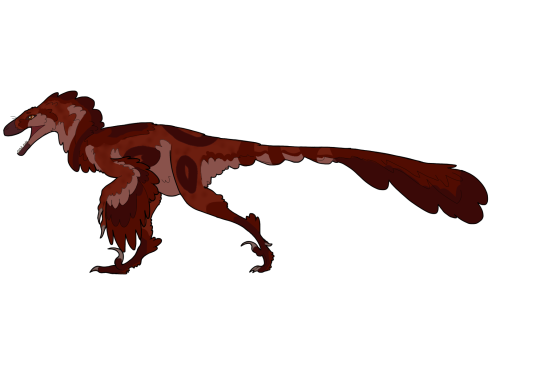
Olivia! i had a little bit of trouble with her, but i think i settled on a good one; she is a Dromaeosaurus albertensis.
Dromaeosaurus was a shier, smaller raptor that lived up north in what is now Canada, enduring freezing polar winters and months of total darkness. it’d take a lot of brains to be able to pull strings to survive that, which Olivia certainly provides. Dromaeosaurus also relied more on the chase and brain power, rather than brute force, though they would’ve if needed be. recent studies also show that raptors probably had very similar capabilities to modern birds, so if they had a brain kind of like corvids, they could’ve even used primitive tools at times. comes in handy with redstone, eh? Dromaeosaurus was also a good tracker, thanks to its sensitive nose and sharp eyes. also, they’re very important but often overlooked. Dromaeosaurus was the leading dinosaur for the names of all under the “raptor” umbrella; the dromaeosaurids.
————————————

Petra! she’s my favorite character, i’ll just admit that lmao. but i gave her the same treatment as everyone else here, so; she is an Austroraptor cabazai.
Austroraptor was a tall, lean, and quick raptor which inhabited the warm swamps of South America. obviously, Petra is the second tallest in The New Order, and Austroraptor was the second tallest raptor on record, so that checks out. but i think the build of Austroraptor checks out too; it’s moderately built, both for speed and strength, with the classic claw. it was very slender and judging from their leg bones, could be a very good pursuit raptor that could also maintain speeds for extended periods of time, which matches Petra’s love to race and run. what sets Austroraptor apart, however, is it’s diet; it was speculated to be at least partially piscivorous, meaning it ate a lot of fish. it’s teeth were slightly conical and acted almost like hooks, which would be quite painful to an opponent. Austroraptor was pretty good at it’s niche, but it wasn’t afraid to go elsewhere if needed. And Petra loves to go elsewhere.
—————————-
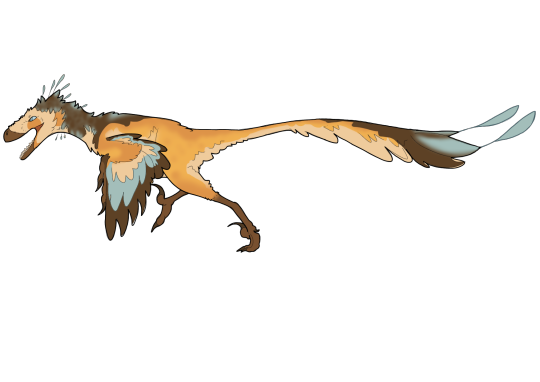
Lukas! he was a little tricky for me to figure out, i’m not gonna lie. i was stuck between these two: Velociraptor mongoliensis and Saurornitholestes langstoni. but i had to choose only one, and i ultimately had to go with a speculative larger subspecies of Velociraptor, since i already broke the size rule with Jesse.
Velociraptor is the most widely known, famous, and beloved raptor of all time, and obviously a fan favorite, so that already checks a box. but adding to this, Velociraptor is a very well-documented dinosaur with some incredible specimens. Velociraptors were also likely to be stealthy and tenacious hunters who used their brains, speed, and ability to take a tumble (which Lukas does a LOT) to their advantage. Lukas is also confirmed in game to be attractive (which is still so funny to me), so i added all kinds of cool looking display feathers in a blue color, because 1) his text and eyes are a blueish color and 2) blue is a kinda rare color in nature, and a lot of birds today seem to like the it. also, in episode 7, remember how his nose wasn’t right in the portrait? i kind of like to imagine that Cassie heard that he was a Velociraptor and assumed he was the Jurassic Park version? so Lukas just comes in, sees the portrait, and is like “where tf are my feathers”
——————-
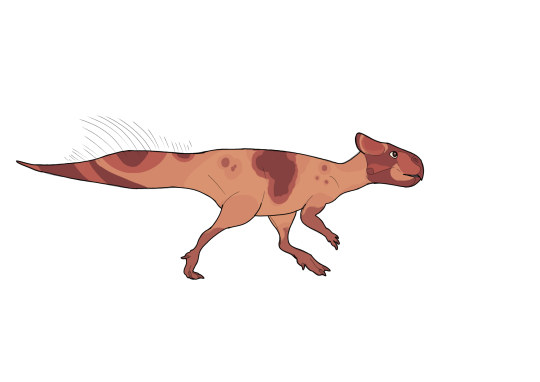
last but not least; Rueben! i had some trouble picking out a genus and species, but i knew immediately that he had to be a small ceratopsian. i chose for him, Microceratus gobiensis.
Microceratus is an adorable looking ceratopsian that was only about the size of a very small dog. but don’t let it’s appearance fool you. ceratopsians have some of the biggest characters and presences in paleontology, with the audacity to match. Rueben definitely has character, personality, and audaciousness. don’t get me wrong, they would probably rather not fight (at least some of them. can’t say the same for Triceratops), but they sure would’ve if they had to. Microceratus doesn’t have a ton of defenses, but it did have a sharp, crushing beak, and could dodge and run very quickly if it had to. it’s front legs were a bit shorter than it’s hind legs, which allowed it to run bipedally. i also just generally think of ceratopsians like the wild boars and rhinos of the dinosaur world, so i guess that just fits, considers Rueben’s main attack is headbutting (which makes me think i could’ve made him a pachycephalosaur too). i just love the idea of this tiny prey creature sticking with a bunch of predators who constantly protect him.
that’s all for now!! thank you for reading and allowing me to infodump about my special interest combined with a hyperfixation lol. i might do more stupid sketches based on this idea in the future if people like it
#my art#mcsm#minecraft: story mode#mcsm au#mcsm jesse#mcsm rueben#mcsm petra#mcsm axel#mcsm olivia#mcsm lukas#dinosaur#dinosaur art#paleoart#drawing#sketch#digital art#raptor#dromaeosauridae#this is so dumb guys i’m so sorry#this is what i get for having a special interest in dinosaurs#dinosaur au
86 notes
·
View notes
Text

You're looking at the largest Dromaeosaurid ever discovered! this is my accurate version of Utahraptor Ostrommaysorum. Utahraptor lived in the early Cretaceous period and was 5 to 7m long and weighed around 0.8 - 1 ton. Even though it was very large and heavy, Utahraptor was able to move very agile like other Dromaeosaurids! Imagine you are walking in the swamp in Utah and meet this creature...
.
.
My Other social media
DeviantArt: Prehistozoo
#utahraptor#dinosaur#reptiles#carnivore#digital art#paleoart#illustration#prehistoric#wildlife#science#Tumblr#theropod
7 notes
·
View notes
Photo

Instead of playing the game I bought (totk) I made an oc instead (not really this is unrelated, relatively)
Based off the Velociraptor (I think the ref said... let me- the Utahraptor ostrommaysorum) and adding a lizalfos gang
8 notes
·
View notes
Text


Name: Tamotsu Tsuyoshi
保 豪志 (Hiragana)
たもつ つよし [Kanji]
Age: 22 years old
Hero name: Utahtor [<Short for Utahraptor ostrommaysorum]
Quick Info: he really loves strawberries!
#bnha#bnha oc#boku no hero acadamia oc#boku no hero academia#mha#mha oc#my hero academy#my hero academy oc#oc#my art#tamotsu tsuyoshi
7 notes
·
View notes
Text
Utahraptor ostrommaysi
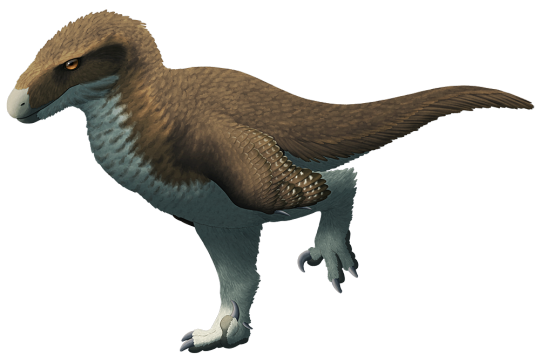
By Nix, CC BY-NC 4.0
Etymology: Thief from Utah
First Described By: Kirkland et al., 1993
Classification: Dinosauromorpha, Dinosauriformes, Dracohors, Dinosauria, Saurischia, Eusaurischia, Theropoda, Neotheropoda, Averostra, Tetanurae, Orionides, Avetheropoda, Coelurosauria, Tyrannoraptora, Maniraptoromorpha, Maniraptoriformes, Maniraptora, Pennaraptora, Paraves, Eumaniraptora, Dromaeosauridae, Eudromaeosauria, Dromaeosaurinae
Status: Extinct
Time and Place: Between 129 and 120 million years go, from the Barremian to the Aptian ages of the Early Cretaceous


Utahraptor is known from the Yellow Cat and Poison Strip members of the Cedar Mountain Formation
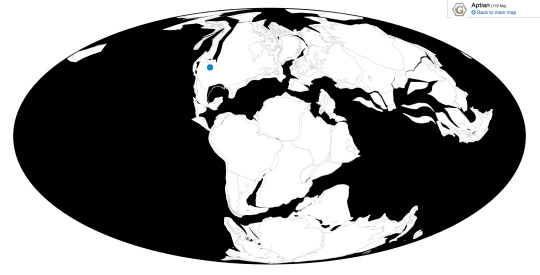
Physical Description: Utahraptor was a very large raptor dinosaur, and had the associated bodily characteristics - a bulky trunk, shorter legs, long arms, large head, and long, stiffened tail. It was really and truly huge, about 7 meters long and 500 kilograms in weight - about the size of a modern Grizzley or Polar Bear, though they might have been heavier than previously thought. Like other raptors, it had huge sickle claws on its feet, and the claws were probably around 24 centimeters long - or even longer, if they had been covered in a keratin sheath as potentially thought. The skull of Utahraptor has not yet been described, so for now we can only say that it had a long, triangular head like other raptors, with sharp serrated teeth. As with other raptors, it would have been feathered - with very large wings for flapping, and a distinctively huge tail fan. The legs of Utahraptor would have been slightly less feathered, but still distinctive. In short, it was a big and fluffy bird-bear, and the largest predator in its environment.

By Matt Martyniuk, CC BY-SA 3.0
Diet: Utahraptor was a large predator and, accordingly, ate large sources of food such as ornithopods and younger sauropods.
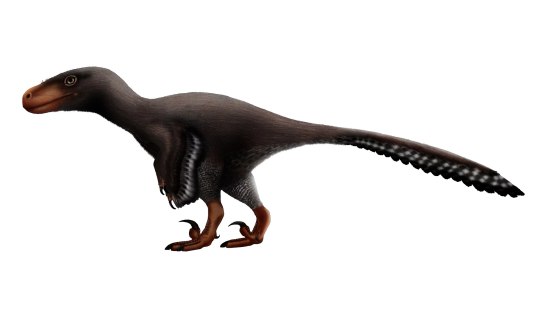
By PaleoNeolitic, in the Public Domain
Behavior: As a raptor, Utahraptor would have been most analogous to a cat - probably stalking alone rather than in packs, and utilizing ambush behavior to trap its prey. Since it had somewhat stubby legs and wasn’t very fast at all, it couldn’t have relied on pursuit to attack its food, even if its food was just as slow as it was. Instead, these powerful legs helped Utahraptor to jump onto its food and surprise it, even from the ground where it spent its time. It then could use raptor prey restraint (RPR) to stay balanced on the prey, flapping its wings rapidly as the prey moved around and tried to escape. Those impossibly large sickle claws then were used to strategically stab at places where the prey would bleed out - important veins and arteries - rather than slash. In addition to this, Utahraptor would have been able to flap its wings rapidly and run up steep surfaces - a technique called Wing-Assisted Inclined Running (WAIR) - even vertical ones, like cliff faces and trees. This allowed Utahraptor to reach strategic vantage points and search for prey - and even jump down onto it from high heights. These techniques allowed Utahraptor to not only hunt the similarly-sized Ornithopods of the time, but also potentially attack the even larger Sauropods with which it shared its home. When it needed a smaller snack, that large claw could be used to pin down struggling furry mammals and lizards, in order for Utahraptor to then take a bite.
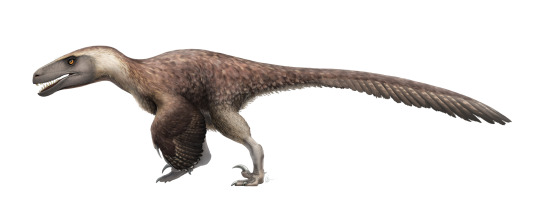
By Fred Wierum, CC By-SA 4.0
Though Utahraptor did not hunt in packs, that doesn’t mean it wasn’t social - and, indeed, there is considerable evidence not yet described that it lived in dense family groups. This would probably mean that adult Utahraptor would go out hunting on their own, while the little ones would gather their own food, before coming together in the same space for safety from other Utahraptor and just to spend the night. It is very likely that Utahraptor took care of its own young based on its relatives - and there’s hopefully more evidence on the way to corroborate this. This was a very complex social animal, using those fancy wings and tail fan to display to other Utahraptor - by holding up the wings and lifting the tail fan to display, it could communicate with others that it was a threat, that it wanted to mate, or to stay away from its nest. In general, it would have behaved very bird-like - walking around, bobbing its head, and moving its head to look for food and for each other rather than moving the eyes. And, like birds, it would have been very active, and warm-blooded.
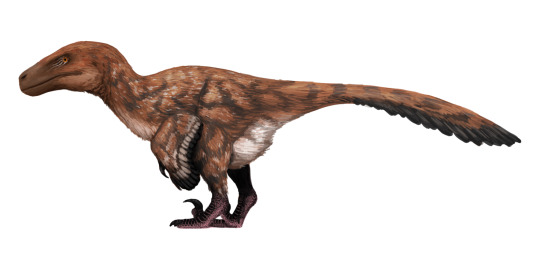
By Ashley Patch
Ecosystem: When the Cedar Mountain Formation supported Utahraptor, it was a very large floodplain environment, that periodically flash flooded and filled the valley with mud. This was a seasonally wet environment with a variety of rivers, forests, prairies, and open woodlands. The ecosystem had a short wet system and a very long, tedious dry season. Utahraptor shared this environment with countless creatures - the tuataran Toxolophosaurus, the turtle Glyptops, a variety of fish, the mammaliaform Cifelliodon, and - of course - other dinosaurs. There was the ankylosaur Gastonia, the large Iguanodon-like Ornithopods Cedrorestes, Hippodraco, and Iguanacolossus; the Sauropods Cedarosaurus and Mierasaurus; the Therizinosaurs Martharaptor and Falcarius; the Troodontid Geminiraptor; the Ornithomimosaur Nedcolbertia; and another raptor - Yurgovuchia! This gave Utahraptor a wide variety of things to hunt in its environment.
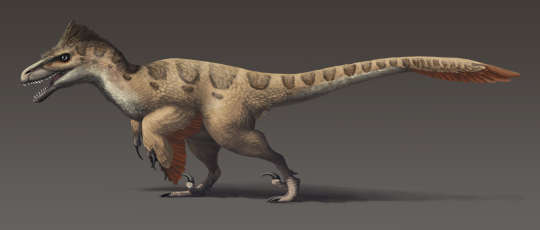
By Emily Willoughby, CC By-SA 3.0
By the time of the later Poison Strip environment, things were changing rapidly in Cedar Mountain. Dry seasons were longer now, and a significant amount of sand was washing through the ecosystem. This made life higher in the floodplain, and probably eliminated many of the forests and river-woods that had been present prior to, leaving only a somewhat scrubland-esque plain. Accordingly, creature diversity actually went down - it was something of an ecosystem collapse. There was still food for Utahraptor to eat - the Ornithopod Planicoxa, and the sauropods Moabosaurus and Venenosaurus; but that was it. Utahraptor, thus, was living in a miniature extinction event - and disappears from the environment by the time the mud and rainy seasons returned in the Ruby Ranch Environment, and the large predator niche was replaced by the carnosaur Acrocanthosaurus.

By Calum O’Halloran
Other: Utahraptor was the largest raptor known, and we actually have many fossils of it - but they’re trapped in a block! Well, there isn’t funding to remove them from the block, anyway. So much more could be (and will be, dammit!) written about this excellent dinosaur if it was adequately funded to be researched properly. Check out the Utahraptor Project if you want to learn more about Utahraptor - and consider donating! Literally every penny helps. Utahraptor is also one of the inspirations for the raptors of Jurassic Park, along with Deinonychus - though, obviously, those creatures do not resemble their real counterparts in the slightest.
~ By Meig Dickson
Sources under the Cut
Apesteguía, S., S. de Valais, G. R. Cordero and O. M. Ramírez. 2011. New ichnological record from the late Campanian Toro Toro Formation at Toro Toro, Potosí (Bolivia): first probably dromaeosaurid tracks from South America. Ameghiniana 48(4):662-667
Aubrey, W.M. 1998. A newly discovered, widespread fluvial facies and unconformity marking the Upper Jurassic/Lower Cretaceous boundary, Colorado Plateau. Modern Geology, v. 22, p. 209-233.
Barco, J. L., and J. I. Ruiz-Omeñaca. 2001. Primeros dientes de terópodo (Dinosauria, Saurischia) en la Formación Villar del Arzobispo (Tithónico-Berriasiense): yacimientos Cuesta Lonsal y Las Cerradicas 2 (Galve, Teruel) [First teeth of a theropod (Dinosauria, Saurischia) in the Villar del Arzobispo Formation (Tithonian–Berriasian): Cuesta Lonsal and Las Cerradicas 2 localities (Galve, Teruel)]. In G. Meléndez, Z. Herrera, G. Delvene & B. Azanza (eds.), XVII Jornadas de la Sociedad Española de Paleontología. Los Fósiles y la Paleogeografía. Ayuntamiento de Albarracín y Fundación Conjunto Paleontólogico de Teruel, Albarracin, Spain 5.1:239-246
Campione, N. E., D. C. Evans, C. M. Brown, M. T. Carrano. 2014. Body mass estimation in non-avian bipeds using a theoretical conversion to quadruped stylopodial proportions. Methods in Ecology and Evolution 5 (9): 913 - 923.
Carpenter, K. 1998. Evidence of predatory behavior by carnivorous dinosaurs. Gaia 15: 135 - 144.
Carpenter, K. 2002. Forelimb biomechanics of nonavian theropod dinosaurs in predation. Senckenbergiana Lethaea 82: 59 - 76.
Carpenter, K., 2006, Assessing dinosaur faunal turnover in the Cedar Mountain Formation (Lower Cretaceous) of eastern Utah, USA. Ninth International Symposium on Mesozoic Terrestrial Ecosystems and Biota, Abstract and Proceedings Volume, p. 21-25.
Carpenter, Kenneth; Bartlett, Jeff; Bird, John; Barrick, Reese (2008). "Ankylosaurs from the Price River Quarries, Cedar Mountain Formation (Lower Cretaceous), east-central Utah". Journal of Vertebrate Paleontology. 28 (4): 1089–1101.
Chure, Daniel; Britt, Brooks; Whitlock, John A.; Wilson, Jeffrey A. (2010). "First complete sauropod dinosaur skull from the Cretaceous of the Americas and the evolution of sauropod dentition". Naturwissenschaften. 97 (4): 379–91.
Cifelli, R. L., Nydam, R. L., Gardner, J. D., Weil, A., Eaton, J. G., Kirkland, J. I., and Madsen, S., 1999, Medial Cretaceous vertebrates from the Cedar Mountain Formation, Emery County, Utah: the Mussentuchit Local Fauna, in, Gillette, D., Vertebrate Paleontology in Utah. Utah Geological Survey Miscellaneous Publication 99-1, p. 219-242.
Britt, B. B., K. L. Stadtman, and R. D. Scheetz. 1996. The Early Cretaceous Dalton Wells dinosaur fauna and the earliest North American titanosaurid sauropod. Journal of Vertebrate Paleontology 16(3, suppl.):24A
Britt, B. B., and K. L. Stadtman. 1997. Dalton Wells Quarry. In P. J. Currie & K. Padian (ed.), Encyclopedia of Dinosaurs 165-166
Britt, B. B., D. A. Eberth, R. D. Scheetz, B. W. Greenhalgh, and K. L. Stadtman. 2009. Taphonomy of debris-flow hosted dinosaur bonebeds at Dalton Wells, Utah (Lower Cretaceous, Cedar Mountain Formation, USA). Palaeogeography, Palaeoclimatology, Palaeoecology 280:1-22
Burnham, D. A., P. Senter, R. Barsbold and B. B. Britt. 2004. Phylogeny of the Dromaeosauridae. Journal of Vertebrate Paleontology 24(3, suppl.):42A
Currie, P. J. 1995. New information on the anatomy and relationships of Dromaeosaurus albertensis (Dinosauria: Theropoda). Journal of Vertebrate Paleontology 15(3):576-591
Currie, P. J. 1997. Dromaeosauridae. In P. J. Currie & K. Padian (ed.), Encyclopedia of Dinosaurs 194-195
Currie, P. J. 2000. Theropods from the Cretaceous of Mongolia. In M. J. Benton, M. A. Shishkin, D. M. Unwin, & E N. Kurichkin (eds.), The Age of Dinosaurs in Russia and Mongolia 434-455
DePalma, R. A., D. A. Burnham, L. D. Martin, P. L. Larson, R. T. Bakker. 2015. The first Giant Raptor (Theropoda: Dromaeosauridae) from the Hell Creek Formation. Paleontological Contributions 14: 1-16.
Dinets, V. 2014. Apparent coordination and collaboration in cooperatively hunting crocodilians. Ethology Ecology & Evolution 27 (2): 244 - 250.
Erickson, G. M., K. Curry Rogers, D. J. Varricchio, M. A. Norell, X. Xu. 2007. Growth patterns in brooding dinosaurs reveals the timing of sexual maturity in non-avian dinosaurs and genesis of the avian condition. Biology Letters 3 (5): 558 - 61.
Fowler, D. W., E. A. Freedman, J. B. Scannella, R. E. Kambic. 2011. The Predatory Ecology of Deinonychus and the Origin of Flapping in Birds. PLoS ONE 6 (12): e28964.
Frederickson, J. A., M. H. Engel, R. L. Cifelli. 2018. Niche Partitioning in Theropod Dinosaurs: Diet and Habitat Preference in Predators from the Uppermost Cedar Mountain Formation (Utah, U.S.A.). Scientific Reports 8: 17872.
Galton, P. M., and J. A. Jensen. 1975. Hypsilophodon and Iguanodon from the Lower Cretaceous of North America. Nature 257:668-669
Gauthier, J., K. Padian. 1985. Phylogenetic, Functional, and Aerodynamic Analyses of the Origin of Birds and their Flight. Hecht, M. K., J. H. Ostrom, G. Viohl, P. Wellnhofer (ed.). The Beginnings of Birds. Proceedings of the International Archaeopteryx Conference, Eichstätt: Freunde des Jura-Museums Eichstätt: 185 - 197.
Gishlick, A. D. 2001. The function of the manus and forelimb of Deinonychus antirrhopus and its importance for the origin of avian flight. In Gauthier, J., L. F. Gall. New Perspectives on the Origin and Early Evolution of Birds. New Haven: Yale Peabody Museum: 301 - 318.
Godefroit, P., P. J. Currie, H. Li, C. Y. Shang, and Z.-M. Dong. 2008. A new species of Velociraptor (Dinosauria: Dromaeosauridae) from the Upper Cretaceous of northern China. Journal of Vertebrate Paleontology 28(2):432-438
Kiernan, K., and D. R. Schwimmer. 2004. First record of a celociraptorine theropod (Tetanurae, Dromaeosauridae) from the eastern Gulf Coastal United States. The Mosasaur 7:89-93
Kirkland, J. I., D. Burge, and R. Gaston. 1993. A large dromaeosaur (Theropoda) from the Lower Cretaceous of eastern Utah. Hunteria 2(10):1-16
Kirkland, J.I., Britt, B., Burge, D., Carpenter, K., Cifelli, R., DeCourten, F., Eaton, J., Hasiotis, S., and Lawton, T., 1997b, Lower to Middle Cretaceous dinosaur faunas of the Central Colorado Plateau: a key to understanding 35 million years of tectonics, sedimentology, evolution, and biogeography. Brigham Young University Geology Studies, v. 42, p. 69-103.
Kirkland, J.I. and Madsen, S.K. (2007). "The Lower Cretaceous Cedar Mountain Formation, eastern Utah: the view up an always interesting learning curve." Fieldtrip Guidebook, Geological Society of America, Rocky Mountain Section. 1-108 p.
Kirkland, J. I., Edward L. Simpson, Donald D. DeBlieux, Scott K. Madsen, Emily Bogner & Neil E. Tibert (2016). Depositional constraints on the Lower Cretaceous Stikes Quarry dinosaur site: Upper Yellow Cat Member, Cedar Mountain Formation, Utah. Palaios 31(9): 421-439; doi: 10.2110/palo.2016.041
Kowallis, B. J., Christiansen, E. H., Deino, A. L., Peterson, F., Turner, C.E., Kunk, M. J., and Obradovich, J. D., 1998, The age of the Morrison Formation. Modern Geology, v. 22, p. 235-260.
Le Loeuff, J., and E. Buffetaut. 1998. A new dromaeosaurid theropod from the Upper Cretaceous of southern France. Oryctos 1:105-112
Longrich, N. R., and P. J. Currie. 2009. A microraptorine (Dinosauria–Dromaeosauridae) from the Late Cretaceous of North America. Proceedings of the National Academy of Sciences
Martyniuk, M. 2016. You’re Doing It Wrong: Microraptor Tails and Mini-Wings. DinoGoss Blog.
McDonald, AT, Kirkland JI, DeBlieux DD, Madsen SK, Cavin J, et al. (2010). Farke AA (ed.). "New Basal Iguanodonts from the Cedar Mountain Formation of Utah and the Evolution of Thumb-Spiked Dinosaurs". PLoS ONE. 5 (11): e14075.
Norell, M. A., and P. J. Makovicky. 2004. Dromaeosauridae. In D. B. Weishampel, P. Dodson, and H. Osmolska (eds.), The Dinosauria (second edition). University of California Press, Berkeley 196-209
Paul, Gregory S. (2016). The Princeton Field Guide to Dinosaurs (2nd Edition). Princeton, New Jersey: Princeton University Press. pp. 151, 163, 229, 252, 314, 319, 326, 327.
Pei, R., Q. Li, Q. Meng, K.-Q. Gao, and M. A. Norell. 2014. A New Specimen of Microraptor (Theropoda: Dromaeosauridae) from the Lower Cretaceous of Western Liaoning, China. American Museum Novitates 3821:1-28
Prum, R.; Brush, A.H. (2002). "The evolutionary origin and diversification of feathers". The Quarterly Review of Biology. 77 (3): 261–295.
Rauhut, O. W. M. 2003. The interrelationships and evolution of basal theropod dinosaurs. Special Papers in Palaeontology 69:1-213
Roca-Argemi, X. and Nadon, G. C. 2003. The Buckhorn Conglomerate as the upper member of the Morrison Formation: new evidence from the type section, Cedar Mountain, Utah. Geological Society of America, Rocky Mountain Section, 55th Annual Meeting, Paper 14-1.
Rothschild, B., Tanke, D. H., and Ford, T. L., 2001, Theropod stress fractures and tendon avulsions as a clue to activity: In: Mesozoic Vertebrate Life, edited by Tanke, D. H., and Carpenter, K., Indiana University Press, p. 331-336.
Ruiz-Omeñaca, J. I., and J. I. Canudo. 2003. Dinosaurios (Saurischia, Ornithischia) en el Barremiense (Cretácico Inferior) de la península Ibérica [Dinosaurs (Saurischia, Ornithischia) in the Barremian (Lower Cretaceous) of the Iberian peninsula]. In F. Pérez Lorente (ed.), Dinosaurios y Otros Reptiles Mesozóicos de España 269-312
Sanders, F.; Manley, K.; Carpenter, K. (2001). "Gastroliths from the Lower Cretaceous sauropod Cedarosaurus weiskopfae". In Tanke, Darren; Carpenter, Ken (eds.). Mesozoic Vertebrate Life: New Research Inspired by the Paleontology of Philip J. Currie. Indiana University Press. pp. 166–180.
Senter, P., R. Barsbold, B. B. Britt and D. A. Burnham. 2004. Systematics and evolution of Dromaeosauridae (Dinosauria, Theropoda). Bulletin of the Gunma Museum of Natural History 8:1-20
Senter, P., J. I. Kirkland, and D. D. DeBlieux. 2012. Martharaptor greenriverensis, a new theropod dinosaur from the Lower Cretaceous of Utah. PLoS ONE 7(8):e43911:1-12
Senter, P.; Kirkland, J.I.; Deblieux, D. D.; Madsen, S.; Toth, N. (2012). Dodson, Peter (ed.). "New Dromaeosaurids (Dinosauria: Theropoda) from the Lower Cretaceous of Utah, and the Evolution of the Dromaeosaurid Tail". PLoS ONE. 7 (5): e36790.
Shapiro, R.S., Fricke, H.C., and Fox, K. 2009. Dinosaur-bearing oncoids from ephemeral lakes of the Lower Cretaceous Cedar Mountain Formation, Utah. Palaios 2(4):51-58.
Smith, D. K. 1997. Museum of Earth Science, Brigham Young University. In P. J. Currie & K. Padian (ed.), Encyclopedia of Dinosaurs 457-458
Stokes, W. L. 1944, Morrison and related deposits in the Colorado Plateau. Geological Society of America Bulletin v. 55, p. 951-992.
Stokes, W.L. 1952. Lower Cretaceous in the Colorado Plateau. American Association of Petroleum Geologists v. 36: 1766-1776.
Sues, H.-D., and A. Averianov. 2014. Dromaeosauridae (Dinosauria: Theropoda) from the Bissekty Formation (Upper Cretaceous: Turonian) of Uzbekistan and the phylogenetic position of Itemirus medullaris Kurzanov, 1976. Cretaceous Research 51:225-240
Switek, Brian (January 7, 2015). "Utah's Dinosaur 'Death Trap' Reveals Trove of Giant Predators". National Geographic. Retrieved April 15, 2017.
Turner, A. H., S. H. Hwang, and M. A. Norell. 2007. A small derived theropod from Öösh, Early Cretaceous, Baykhangor Mongolia. American Museum Novitates 3557:1-27
Turner, Alan H.; Pol, D.; Clarke, J.A.; Erickson, G.M.; Norell, M. (2007). "A basal dromaeosaurid and size evolution preceding avian flight". Science. 317 (5843): 1378–1381.
Turner, AH; Makovicky, PJ; Norell, MA (2007). "Feather quill knobs in the dinosaur Velociraptor". Science. 317 (5845): 1721.
Weishampel, David B.; Dodson, Peter; and Osmólska, Halszka (eds.): The Dinosauria, 2nd, Berkeley: University of California Press. 861 pp.
Williamson, T. E., and S. L. Brusatte. 2014. Small theropod teeth from the Late Cretaceous of the San Juan Basin, northwestern New Mexico and their implications for understanding latest Cretaceous dinosaur evolution. PLoS ONE 9(4):e93190:1-23
Xu, X.; Zhou, Z.; Wang, X.; Kuang, X.; Zhang, F.; Du, X. (2003). "Four-winged dinosaurs from China". Nature. 421 (6921): 335–340.
#Utahraptor ostrommaysi#Utahraptor#Dinosaur#Utahraptor ostrommaysorum#Raptor#Bird#Dromaeosaur#Birds#Feathered Dinosaurs#Dinosaurs#Birblr#Palaeoblr#Factfile#Cretaceous#Carnivore#Theropod Thursday#North America#paleontology#prehistory#prehistoric life#biology#a dinosaur a day#a-dinosaur-a-day#dinosaur of the day#dinosaur-of-the-day#science#nature
728 notes
·
View notes
Photo


The only two art fight attacks I finished,, :,)
1st is to -_Deoxys_- and the second is to Fishbugg_, both on Artfight c:
#art fight#art fight 2020#team spice#art trade#oc#original character#robot#robot oc#mech#mecha#dinosaur#dinosaur art#paleoart#dinosaur oc#utahraptor#utahraptor ostrommaysorum#sci-fi#science fiction#digital art#procreate
4 notes
·
View notes
Text

On the hunt
10 notes
·
View notes
Photo

Walking with Dinosaurs: Utahraptor by TrefRex
#Palaeoblr#Walking with Dinosaurs#Walking with Dinosaurs (1999)#WWD#Utahraptor#Utahraptor ostrommaysorum#Theropod#Dinosaur#Prehistoric#Cretaceous#Mesozoic#Extinct
37 notes
·
View notes
Text
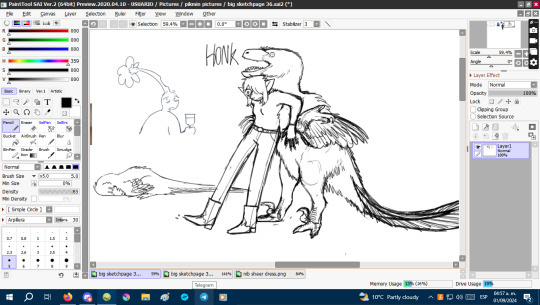
big ass bird. featuring a friend's character for reference. and nib daydrinking
56 notes
·
View notes
Text
Helen

Name: Helen
Species: Utahraptor ostrommaysorum
Description: Utahraptor is the largest and chunkiest Dromaeosaur. Hailing from Utah of the early Cretaceous, around 126 Ma, it’s about 6.5 meters (21 feet) long and weighs over 400 kg (900 lbs)! Helen’s sickle claws are almost 23 cm (9 inches) long! Originally known from a single fossil, there are many more specimens in preparation that show Utahraptor was stocky and short-legged, similar to its Mongolian relative Achillobator. Unusually, the tip of its lower jaw has a slight downturn, most visible when the mouth is open. Utahraptor probably specialized in larger prey, such as the iguanodont Hippodraco.
Location: Helen lives in a large, fairly open enclosure in the Raptor! exhibit.
Fun Facts: The guano is... far from pleasant.
About the Individual: Helen is our only Utahraptor, and quite a grouch. Not a dinosaur you’d want to mess with. She’s hostile towards anyone and anything she doesn’t like - including keepers, the occasional visitor, and that one tree. Particularly if she’s brooding. She spends most of her time in the brushiest area of the enclosure brooding, out of sight from most angles.
Helen is the recipient of a variety of enrichment tests. She is the first of our animals to try a new form of enrichment - a large mechanized boomer ball, custom-built by Sphero - and she’s taken well to it. We plan to incorporate this with more predators soon. And even though she generally dislikes keeper interaction, she loves getting bloodsicles - especially on the hot days we’ve been having.
Although seemingly fine with being solitary, Helen does show brooding behavior. She’s built a makeshift nest with molted feathers and sticks gathered from around the enclosure and spends lots of time at it. We’re testing out ways to deal with this, including putting painted rocks in the enclosure to act as eggs.
Speaking of Utahraptor, we encourage you to participate in #UtahraptorWeek next week to show love for raptors such as Helen and bring awareness to the Utahraptor Project!
#thhpg#aotw#utahraptor#utahraptor ostrommaysorum#raptor!#march2017#helen#UtahraptorWeek#palaeoblr#huxley paleozoo
83 notes
·
View notes
Text

An illustrated assortment of some of the various dinosaurs (all of them shown not to scale for convenience) that inhabit the semiarid Early Cretaceous neighborhood of Utahraptor ostrommaysorum. Among the most unusual of these neighbors are the indeterminate sail-backed Iguanodontian that has still not been formally described, the small but highly-enigmatic Therizinosaur Martharaptor, and the Turiasaurid Mierasaurus, which is a rare Cretaceous and North American representative of an otherwise mainly Jurassic and European family of sauropods.
#paleoart#dinosaur#dinosaurs#paleontology#utahraptor#dromaeosaurs#dromaeosaurid#dromaeosaur#iguanacolossus#cedarosaurus#ornithopods#ornithomimosaur#ornithischian#sauropod dinosaur#sauropod#palaeontology#palaeoart#paleoblr#paleoartist#paleoartists on tumblr#paleontologie#paleontology art#palaeoblr#paleontography#early cretaceous#theropod dinosaurs#theropod dinosaur#theropods#paleoillustration#falcarius
138 notes
·
View notes
Photo

THIS IS A COMMISSION. IN MOST CASES I DO NOT MIND PEOPLE REFERENCING MY ART. HOWEVER YOU ART NOT ALLOWED TO COPY, REPLICATE, OR STEAL THIS IMAGE IN ANY WAY. --- This is a commission that's been in the works for around 5 months. The probable hour count in this piece is around 25-30, if not more than that. Due to being so ill, normally I would've gotten this finished waaay sooner than this, but with me being bedridden most days, it was hard. Though it's finished, and I'm quite satisfied with the result. Also, a many thanks to the commissioner for being so patient and for being a steady client. I'm looking forward to creating more works! The commissioner has a fan fiction that is involved in the Land Before Time universe. His Utahraptor character used to be a human at one point, though he becomes a giant raptor(even for his species) and is sent back millions of years in time. During the "transformation" he comes face to face with the monster he was going to become. That is the moment that this piece is representing. Enjoy!
#utahraptor#julianR94#the land before time#tlbt#specter#utahraptor ostrommaysorum#illustration#theropod#human#raptor#amandakeesler#amanda keesler art#amandakeesler art#amanda keesler#demonic-pokeyfruit#demonicpokeyfruit
8 notes
·
View notes
Note
hi it's the anon from before i'm pretty sure i followed u for the old guard stuff?? plsplspls tell me abt the official state dinosaurs
i am just WAITING for the day we get smth substantial for tog2 and then i promise i will be feral about tog again aksjgdka
okay so there are fourteen states with official state dinosaurs and most of them are quite frankly dinos ive never heard of (have to admit i dont know a lot about dinos which is on me really! and im sorry for it)
arizona - sonorasaurus thompsoni arkanas - arkansaurus fridayi california - augustynolophus morrisi colarado - stegosaurus armatus conneciticut dilophosaurus sp. (which i keep reading as dilfosaurus which is importantt to share i think) distric of columbia - "capitalsaurus" (wiki had the quotes not me) massachusetts - podokesaurus holyokensis maryland - astrodon johnstoni missouri - parrosaurus missouriensis new jersey - hadrosaurus foulkii oklahoma - acrocanthosaurus atokensis texas - sauropoiseidon proteles (which replaced i believe the astrodon in 2009) utah - utahraptor ostrommaysorum wyoming - triceratops horridus
#abby replies#anon#adksg instead of doing the smart thing (copying and pasting) i typed almost every single one of these out asdjlgk
3 notes
·
View notes